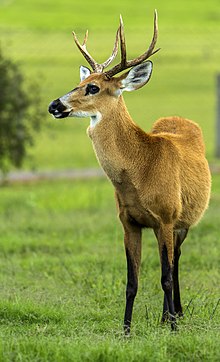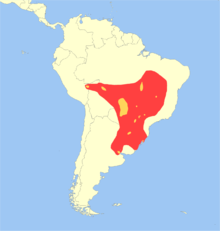Marsh deer
| Marsh deer | |
|---|---|
 |
|
| Male marsh deer | |
| Scientific classification | |
| Kingdom: | Animalia |
| Phylum: | Chordata |
| Class: | Mammalia |
| Order: | Artiodactyla |
| Family: | Cervidae |
| Subfamily: | Capreolinae |
| Genus: |
Blastocerus Wagner, 1844 |
| Species: | B. dichotomus |
| Binomial name | |
|
Blastocerus dichotomus (Illiger, 1815) |
|
 |
|
| Geographic range: Red=Former; Yellow=Present | |
The marsh deer (Blastocerus dichotomus) is the largest deer species from South America reaching a length of 2 m (6.6 ft) and a shoulder height of 1.2 m (3.9 ft). It is found in Argentina, Bolivia, Peru, Brazil, Uruguay and Paraguay. Formerly found in much of tropical and subtropical South America, it ranged east of the Andes, south from the Amazon rainforest, west of the Brazilian Atlantic rainforest and north of the Argentinian Pampa. Today it is largely reduced to isolated populations at marsh and lagoon zones in the Paraná, Paraguay, Araguaia and Guapore river basins. Small populations also occur in the southern Amazon, including Peru where protected in Bahuaja-Sonene National Park. It is listed as a vulnerable species by the IUCN and on CITES Appendix I.
The latter half of its scientific name refers to the forked antlers. Marsh deer resemble the North American mule deer or blacktail deer.
The marsh deer lives only in marsh areas, notably the Pantanal and Chaco, in which the level of water is less than 70 cm (28 in) deep. They are swift swimmers. The marshes with their high vegetation density protect them from predators and provide them with food. These deer also have a small migratory pattern, they follow the water levels between the dry season and flooding season. With the fluctuation in water levels, they are able to find new food sources that the water uncovers during the dry season. Some freshwater ponds on the Pantanal Wetland, Brazil reported low densities of individuals dictating that those ponds are not able to support large populations of marsh deer.
...
Wikipedia

